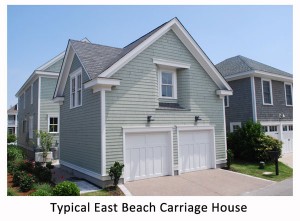You are currently browsing all posts tagged with 'in-law'.
Why OUTLAW In-law Apartments? ….arguments for legalizing Accessory Dwelling Units
posted on Thursday, November 7th, 2013 at 2:28 pmThe concept of an In-law apartment or an Accessory Dwelling Unit is highly acclaimed by city planners, sometimes in the same cities that prohibit them. Take the language of the Virginia Beach zoning ordinance as a case in point. Section 507 of its code sanctions the value of constructing semi-private living quarters for a senior family member on a property zoned for single family occupancy. It reads: The purpose of this section is to enhance the opportunities for affordable housing and independent living available to senior citizens and disabled persons, while maintaining the tranquility and integrity of single-family residential neighborhoods.
Section 507 goes on to list several things that are not allowed in such living quarters, limits the size of the quarters to 500 SF, and sets forth additional permit application requirements, including occupancy renewal every two years. What purpose does this ordinance serve? Does it discourage In-law suite projects rather than encourage them? Would a homeowner interested in building such a project be motivated to reveal to the permits office what they are doing? The answers “None, Yes, and No” are the obvious response.
This is a significant issue. Housing need surveys have determined that the demand for such projects has been increasing steadily, especially in recent years, as the baby boomer generation is entering their retirement years. The sad truth is that too many In-law apartments that have been built are illegal or at least under the radar of permitting authorities that have not seen fit to create a proper ordinance to meet the demand. Progressive localities have addressed this housing need by adopting ordinances that guide such development rather than discourage it.
An In-law apartment might be an apartment over a garage or a basement suite. Other variations are dwellings attached to a single-family home or a living space completely detached from the home, like a small guest house. It all cases they should their own entrance, kitchen, bathroom and living space. Common space, such as laundry rooms and living rooms, are usually allowed. The separated living space required is generally from 400 to 800 square feet.
Typical of the arguments against allowing in-law apartments are imagined parking problems, overcrowding, increased traffic and aesthetic impact on a neighborhood. Planners generally agree that all of these issues can be addressed in properly worded provisions of an ordinance that allows In-law apartments in at least some designated residential zoning district categories. Some 13 years ago, the AARP, in consort with the APA, American Planning Association, published a model ordinance guideline for what it called ACCESSORY DWELLING UNITS, ADU’s. The guideline continues to serve as a valuable resource today for jurisdictions writing their own provisions for permitting ADU’s in designated zoning districts.
In a research study published in 2008 by HUD, Office of Policy Development and Research, it concluded: Communities find that allowing accessory dwelling units is advantageous in many ways. In addition to providing practical housing options for the elderly, disabled, empty nesters, and young workers, ADUs can provide additional rental income for homeowners. ADUs are smaller in size, do not require the extra expense of purchasing land, can be developed by converting existing structures, and do not require additional infrastructure.
The HUD study was derived by investigating the experience of several zoning jurisdictions that had adopted ADU ordinances including one in Virginia, Fauquier County, where permit approval depends the size of the property, and availability of septic/sewer and water services. Each of three different types of units is approved by the Fauquier Office of Zoning Permitting and Inspections, provided that the units meet zoning requirements. According to the county’s zoning office, 155 accessory dwelling units and 37 efficiency apartments were permitted from 1997 to 2007.
Call them Accessory Dwelling Units or In-law suites, they are an inexpensive way for municipalities to increase their housing supply, while also increasing their property tax base. By providing affordable housing options for low- and moderate-income residents, communities can retain population groups that might otherwise be priced out of the housing market. When accessory dwellings are allowed in the community, homeowners can generally qualify for home improvement loans to finance the construction or remodel.
Tags: AARP, accessory, ADU, affordable, APA, apartments, dwelling, housing, in-law, suites, units, zoning
REMODELING and ADDITION TIPS: an independent lifestyle for seniors
posted on Tuesday, November 5th, 2013 at 10:35 amThe topic of building and remodeling a home for long-term independence is called Aging-in-Place. It is becoming an increasingly important market niche for contractors and home designers since the largest population segment of society is entering the age of their senior years.
Surveys have determined that more than 90% of older adults prefer to remain in their own home into their later years and to make improvements to that home for their own comfort and convenience or downsize into a smaller home with accessibility and convenience features that are already built into the house. In the process of making improvements to their present home it is likely they will increase the property value of that home and would benefit from the advice of remodelers qualified to prioritize projects and improvements that will provide the greatest value for the money.
Remodelers who specialize in this market can earn a certification from completing a training program conducted by the National Association of Home Builders. It is called CAPS or Certified Aging-in-Place Specialists. The CAPS designation is earned by remodeling contractor candidates and designers who successfully complete the coursework prescribed by a joint program designed by NAHB and AARP.
Demographics suggest that the need for this kind of a remodeling project are likely to increase into the future as census data has shown that more than 4 million households already have 3 generations of family members living under the same roof. A survey by the AARP and the National Alliance for Care Giving has determined that more than 35 million households are looking after a family member that is 50 years old or older and some 10 million of these households live with that person.
The generation of baby boomers is the larger generation segment in the American Population, some 80 million of them. They have already begun entering the 60+ age group and will continue to do so over the next 20 years. The individual differences of how they choose to live out their senior years ranges from a segment resisting traditional retirement, others not admitting they are getting older, and some others are simply living longer healthier lives.
Regardless of the individual lifestyle differences of 60+ year old citizens they do likely recognize some limitations to their existing homes. They are probably looking to make some changes to their home so they can stay there as long as possible. The improvements that they are likely to be considering come under the heading of Universal Design that will serve themselves as well as be useful to a younger generation household in a future resale.
Sometimes the remodeling effort is about a household interested in making their home accessible and comfortable for a parent moving in. Other times the project is about improvements to the existing home for aging-in-place for themselves. A common project for the parent or grandparent that is moving into the home of a younger household member is a semi-separated bedroom suite, likely on the first floor level.
 The local zoning ordinances of most municipalities have made attempts to make allowances for additions to homes that provide senior suites. In Virginia Beach a provision has been made for just such an addition that is called a Flex Suite and makes some allowance for separate kitchen facilities in the addition. In neighborhoods like East Beach in Norfolk, VA, the ordinance allows for complete cooking facilities in separate Carriage House apartment and even allows for a renter to occupy the apartment.
The local zoning ordinances of most municipalities have made attempts to make allowances for additions to homes that provide senior suites. In Virginia Beach a provision has been made for just such an addition that is called a Flex Suite and makes some allowance for separate kitchen facilities in the addition. In neighborhoods like East Beach in Norfolk, VA, the ordinance allows for complete cooking facilities in separate Carriage House apartment and even allows for a renter to occupy the apartment.
A convenient bathroom is a critical feature of home to be made accessible in the senior suite. One attractive feature is a roll-in shower, eliminating the need of a raised threshold. The tile décor of this style of shower is not without an appeal to a general population of home buyers attracted to a feeling of openness, naturally lighting and airiness. Other basic improvements to bathrooms could include better lighting, accessible toilets, and contrasting colors. It is also smart to install blocking inside open stud walls for future installation of grab bars.
A senior suite addition on the first floor is not the only option for an aging-in-place improvement. When the property doesn’t allow for it or the homeowner preference is for the senior or master suite to be located on a second floor there is the option for installing an elevator or improving an existing stairway to provide a motorized lift seat. As the projects grow in complexity the necessity for advice from a licensed architect and/or a CAPS contractor will become an obvious first step. Equivalent to CAPS certification courses for Virginia architects is the Universal Design certification provided by Virginia Housing Development Authority, VHDA.
Tags: aging, Aging-in-place, CAPS, care-giver, fex-suite, in-law, independence, remodeling, senior, suites, universal design, VHDA


